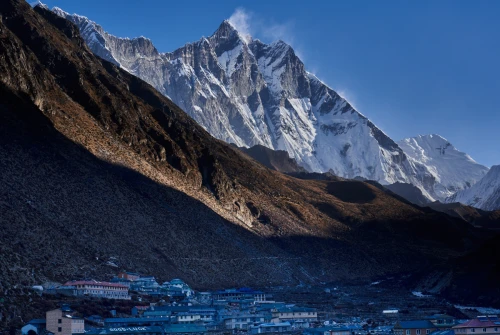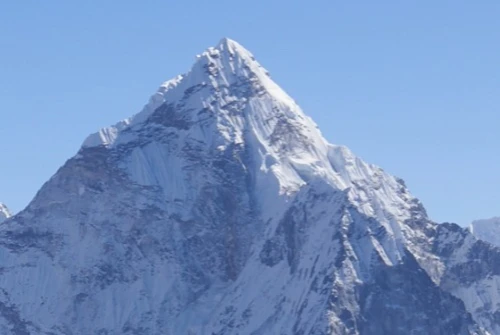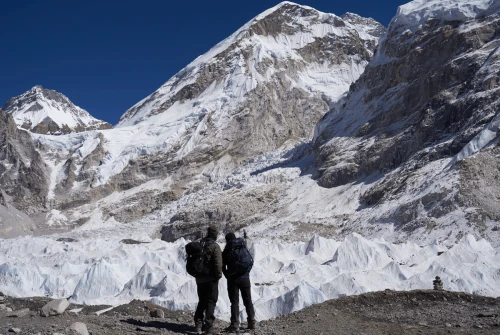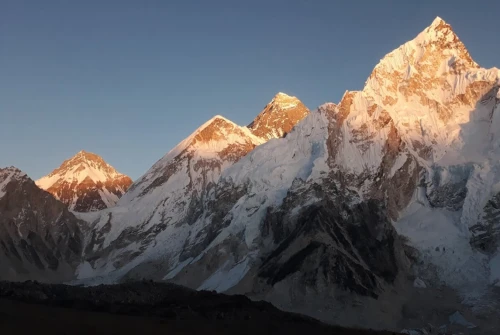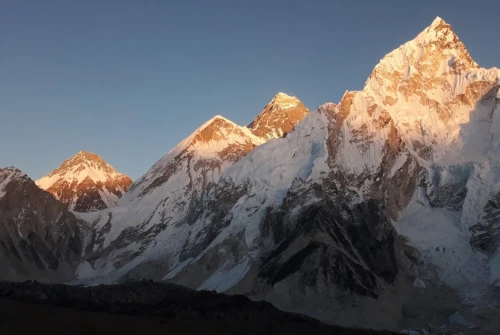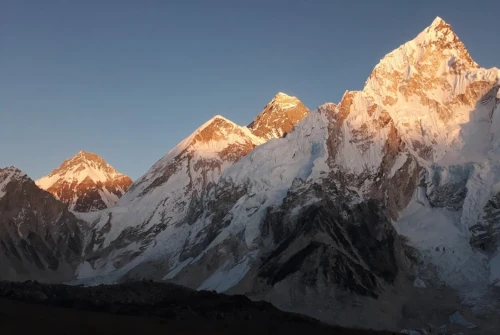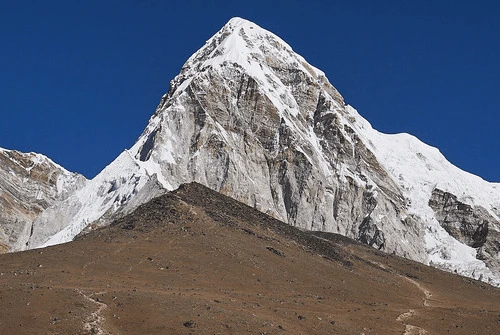Duration:12 Day Everest Base Camp Budget Trek - 12 Days
US$999US$1475Duration:13 Day Everest Base Camp Trek Bed and Breakfast – 13 Days
US$855US$1399Duration:13 Days Everest Base Camp Trek – 13 Days
US$1049US$1549Duration:14 Days Everest Base Camp Trek - 14 Days
US$1199US$1699Duration:15 Days Mount Everest Base Camp Trek – 15 Days
US$1449US$1799Duration:17 Days Everest Base Camp Trek by Road – 17 Days
US$1130US$1600Duration:14 Days EBC Trek 14 Days
US$1149US$1649Duration:12 Days Everest Panorama Yoga Trek – 12 Days
Duration:16 Days Everest Base Camp Trekking for Seniors
Duration:14 Days Everest Base Camp Hike
US$1149US$1649Duration:14 Days Everest Base Camp Trek: Overnight at Base Camp
US$1449US$1749Duration:19 Days Island Peak Climbing with EBC Trekking - 19 Days
US$1999US$2499Duration:10 Days Everest Short Trek - 10 Days
Duration:5 Days Everest View Trek- 5 Days
US$799US$999Duration:16 Days Gokyo Chola Pass Everest Base Camp Trek - 16 Days
US$1499US$1749Duration:20 Days Everest Three Passes Trek - 20 Days
US$1649US$1999Duration:17 Days Extended Everest Base Camp Trek 19 Days
US$1749US$1849Duration:14 Days Everest Base Camp Trek (EBC) for Indian Citizens
US$849US$1249Duration:19 Days Everest Base Camp and Gokyo Valley Trek-19 Days
US$1599Duration:24 Days Everest Base Camp via Jiri Trek - 24 Days
US$1700Duration:13 Days Gokyo Ri Trek - 13 Days
US$1349Duration:8 Days Everest Base Camp Trek - 8 Days
US$1699US$2299Duration:9 Days Pikey Peak Trek – 9 Days
US$799US$899
The Everest Region Trek, also known as the Khumbu Trek, is one of the most renowned and sought-after trekking destinations worldwide. This extraordinary Himalayan region attracts adventurers, nature lovers, and cultural enthusiasts from across the globe, offering unparalleled access to some of the planet’s tallest peaks, including the iconic Mount Everest (8,848.86 meters). Trekkers come here not only for the breathtaking panoramic views of Everest but also to immerse themselves in the rich Sherpa culture, ancient religious traditions, and the spiritual ambiance of the Himalayas.
The Everest or Khumbu region is often called the Sherpa Kingdom of the Himalayas, where trekkers can witness stunning landscapes that range from lush forests and pristine rivers to rugged high-altitude terrain adorned with prayer wheels and colorful prayer flags fluttering along the trails, adding a sacred and spiritual dimension to the journey.
One of the most spectacular highlights of the trek is the view of Mount Everest from Kala Patthar, a vantage point renowned for its unmatched panoramic vista of Everest and the surrounding Himalayan giants.
This region offers a variety of trekking routes suitable for all ages and fitness levels, making it accessible whether you are a novice trekker or an experienced mountaineer. Popular trekking programs include the classic Everest Base Camp Trek, the challenging Three Passes Trek (covering Renjo-La Pass, Cho-La Pass, and Kongma La Pass), the scenic Gokyo Valley Trek, the shorter Everest View Trek, the traditional Jiri to Everest Base Camp Trek, and the exclusive Everest Base Camp Helicopter Tour.
At All Nepal Hiking, we tailor these Everest Region treks to match your interests, fitness level, and schedule, ensuring a personalized and memorable experience. Age is no longer a barrier to exploring the Everest region and witnessing the majestic Mount Everest in all its glory.
Top Trekking Routes in the Everest Region
Explore the best trekking routes in Nepal’s legendary Khumbu (Everest) Region, each offering unique experiences from challenging high-altitude adventures to scenic cultural journeys. Here are the top five treks in the Everest Region:
Everest Base Camp Trek (EBC Trek)
The Everest Base Camp Trek is the crown jewel of Himalayan trekking and one of the world’s most iconic journeys. Beginning with a scenic flight to Lukla, the trail winds through charming Sherpa villages like Phakding, Namche Bazaar, Tengboche, Dingboche, and Lobuche, leading you to Everest Base Camp (5,364m) and Kala Patthar (5,545m) a dramatic viewpoint for jaw-dropping sunrise views of Mount Everest. This trek combines breathtaking mountain scenery, deep Buddhist culture, and warm Sherpa hospitality, making it a bucket-list adventure for trekkers around the globe.
Gokyo Lakes & Gokyo Ri Trek
The Gokyo Lakes Trek offers a peaceful and stunning alternative to the classic EBC route. You’ll journey through the serene Gokyo Valley, home to Nepal’s highest freshwater lake system and the magnificent Ngozumpa Glacier. The highlight is the climb to Gokyo Ri (5,360m), from where you'll get sweeping views of Everest, Cho Oyu, Makalu, and Lhotse, an even more panoramic perspective than Kala Patthar. Ideal for trekkers seeking off-the-beaten-path serenity, this trek offers tranquility, beauty, and unmatched alpine views.
Everest View Trek
Short on time but want to see Everest? The Everest View Trek is a perfect choice for beginners or travelers looking for a less strenuous route. This trek takes you up to Khumjung or Tengboche, where you'll enjoy close-up views of Ama Dablam, Lhotse, and Mount Everest, without the need to reach base camp. Along the way, you'll visit Tengboche Monastery, explore Sherpa communities, and immerse yourself in Himalayan spirituality all within a week.
Everest Three Passes Trek
For adventure seekers and seasoned trekkers, the Everest Three Passes Trek is the ultimate Himalayan challenge. This high-altitude circuit trek crosses three stunning mountain passes Kongma La (5,535m), Cho La (5,420m), and Renjo La (5,360m) linking the Everest Base Camp, Gokyo Valley, and Imja Valley routes into one epic loop. This trek rewards you with raw wilderness, fewer crowds, and diverse scenery from glacial moraines to turquoise lakes.
Everest Panorama Trek
The Everest Panorama Trek is a short and scenic trekking option perfect for families, older travelers, or those who prefer a lower altitude adventure. Typically reaching Tengboche, this route gives you dazzling views of Everest, Ama Dablam, and other peaks without venturing too high. The trail includes visits to traditional Sherpa villages, Buddhist monasteries, and rhododendron forests, offering an authentic taste of Khumbu’s natural and cultural wonders.
Trekking Permits for Everest Region
To trek in the Everest Region (Khumbu Region) of Nepal, you must obtain the following two permits:
Sagarmatha National Park Entry Permit – This is required to enter and trek within the protected area of Sagarmatha National Park, which includes major trails like Everest Base Camp, Gokyo, and Three Passes.
Khumbu Pasang Lhamu Rural Municipality Permit – This local permit has replaced the TIMS card in the Everest Region since 2018 and is issued by the rural municipality to support local infrastructure and conservation efforts.
Note: The TIMS (Trekkers’ Information Management System) Card is not required for trekking in the Khumbu Region since 2018.
Why Trek the Everest Region?
The Everest Region remains one of the world’s most popular and iconic trekking destinations, attracting adventure travelers, nature lovers, and cultural explorers. Here’s why you should choose Everest trekking in Nepal:
1. World-Class Mountain Views of Everest and Himalayas
Trek amidst breathtaking Himalayan peaks like Mount Everest (8,848.86m), Lhotse, Ama Dablam, and Nuptse. Iconic viewpoints such as Everest Base Camp and Kala Patthar offer unforgettable panoramic vistas, making the Everest Base Camp Trek one of the best mountain treks worldwide.
2. Unique Sherpa Culture and Tibetan Buddhist Monasteries
Experience the rich and vibrant Sherpa culture by visiting traditional villages and spiritual sites like Tengboche Monastery and Khumjung Village. The Everest Region is a cultural hotspot for those interested in Tibetan Buddhism, Himalayan festivals, and authentic Nepalese mountain lifestyle.
3. Easy Accessibility via Lukla Flight
The region is easily accessible with short daily flights from Kathmandu to Lukla Airport, the gateway to the Everest trekking trails. Alternatively, adventurous travelers can opt for overland routes to reach the start of the trek.
4. Diverse Trekking Routes for All Levels
Whether you are planning a short Everest View Trek (5 days), the classic Everest Base Camp Trek (12–14 days), or the challenging Everest Three Passes Trek (20+ days), the Khumbu offers trekking routes for beginners, intermediate hikers, and experienced mountaineers alike.
5. Adventure and Natural Beauty: High Passes, Glaciers & Wildlife
Cross high Himalayan passes such as Kongma La and Cho La, walk beside vast glaciers like the Ngozumpa Glacier, and spot unique Himalayan wildlife, including the elusive snow leopard and Himalayan tahr. The Everest Region combines thrilling adventure with serene alpine lakes and pristine mountain landscapes.
Best Seasons for Everest Trekking | When to Trek Everest Region
Choosing the right time to trek the Everest Region is crucial for a safe and enjoyable experience. Each season offers unique landscapes and conditions, but some are better suited for trekking than others.
Spring (March to May)
Spring is one of the most popular seasons for the Everest Base Camp Trek and other Everest treks. The rhododendron forests burst into vibrant blooms, painting the valleys with red and pink hues. Clear skies and moderate temperatures create ideal trekking conditions, offering spectacular mountain views and comfortable daytime temperatures. This season is perfect for nature lovers and photographers.
Autumn (September to November)
Autumn is considered the best trekking season in Everest due to its stable weather, crisp air, and excellent visibility. After the monsoon rains, the skies clear, revealing breathtaking panoramic views of Everest, Lhotse, and surrounding Himalayan peaks. This period also coincides with several local festivals, allowing trekkers to experience rich Sherpa culture and traditions.
Winter (December to February)
Winter trekking in the Everest Region means fewer crowds and a peaceful atmosphere, but it also brings cold temperatures and snow-covered trails. While challenging, the winter months offer pristine white landscapes and stunning sunrises over snow-capped peaks. Trekkers should be well-prepared for sub-zero temperatures, especially at higher altitudes, and expect some lodges to be closed.
Monsoon (June to August)
The monsoon season is generally not recommended for Everest trekking due to heavy rainfall, slippery trails, and poor mountain visibility caused by clouds and fog. The rains increase the risk of landslides and make trekking difficult and less enjoyable. However, the lower valleys become lush and green during this period.


 based on 9 reviews
based on 9 reviews